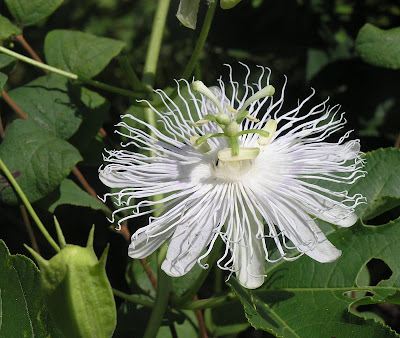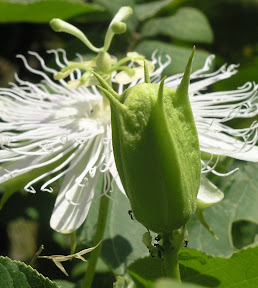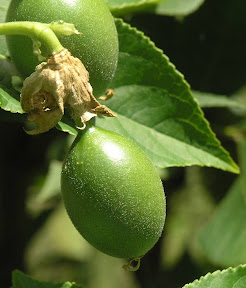
Passionflower (Passiflora incarnata)
Passionflower is a native, perennial vine growing in the southeastern United States. Its vine can be up to 25 feet long and climbs with axillary tendrils or sprawls along the ground. It spreads by root suckers. The vine dies back to the ground during winter, but re-emerges in the spring.
Passionflowers are often purple, but can range from a deep purple to almost pure white. All passionflowers I've found around here are white, although you can see a slight tinge of purple in some of the fringe. Many different pollinators from bees to butterflies nectar on the passionflower and it is a larval host for Gulf Fritillary, Zebra Longwing, Crimson-patch longwing, Red-banded hairstreak, Julia butterfly, Mexican butterflies.
Other common names: Apricot vine, Maypop, Purple passionflower. The name passionflower was given to the plant by early Spanish explorers and relates to the resemblance of the floral parts to aspects of the Christian crucifixion of Christ story.
Some consider passionflower and invasive weed. It does spread, but I've never found it to be all that aggressive. I consider it to be the prettiest, most exotic-looking native wildflowers you're ever going to find growing around the edges of an Arkansas cow pasture.

A Passionflower bud.

Passionflower Fruit (Maypop)
When a passionflower fruit is ripe, it turns yellow and is said to be edible, though I've never tried one. The fruit should be left to ripen on the vine and various woodland creatures are less patient than I. A ripe fruit is filled with a juicy, seedy pulp that is supposed to taste like guavas, which I've never tasted either.
If stepped on, the fruit is said to pop loudly when crushed. Hence, the name of the fruit and another common name for the passionflower plant. (I've never gone out and stomped on a maypop either. What a boring life I lead.)
Sources and Additional Information:
Floridata
Lady Bird Johnson Wildflower Center
2bn The Wild
Alabama Wildflowers
USDA Plants Database
Missouri Flora



12 comments:
Nice pops! It grows like crazy along the old logging roads in the swamp, but I've never seen a white one before, just purple - and gaudy purple at that. Around here, the passionflower serves as a host plant for the variegated fritillary.
Very interesting, Marvin...
My parents had a fence covered with passion-vine, as we called it...
I always wondered, sort of , but never heard why it was called "passion", --and I'm not quite ready to buy your explanation (pardon me) untl I can check into this further to get some confirmation, but you have definitely "aroused" my curiosity...
love it, marvin... have never seen one, and your pics/comments add to my knowledge... thank you
When I was little, an aunt and uncle had a passion flower plant growing along a whole side of a fence. I loved the plant--the flowers and the fruit (which we loved to step on for the "pop").
I've never seen white or never seen them in the wild. I would love to see one in the wild.
thanks for the photos and explanations!
Goodness sakes Marvin. You should line up some entertainment. I can just see you and Jo out there stomping and popping.
The Passion vine is beautiful. I have never seen one here in the wild. I wonder if our winters are too cold. Hmmmmm
This is an excellent post, Marvin. I read it twice. I don't think we have it here and I know I have not seen it but I might be worth looking for.
Beautiful... And wonderful photos.
Oh come on, now is the time to live dangerously! Go find one and stomp on it! Does it pop?!? Report back! We await with baited breath!!!!!!! ,-)
Mari-Nanci
Over here one of these growing in a pot to be planted in the garden would cost around $15.. Start taking cuttng not andI'll arrange the shipping.. :O)
I had a purple one in the garden for a few years but a spring time frost killed it off
Boring life, my rump! You live a life full of enrichment, enjoyment & learning. Keep up the good work!
Your passionflower's so lovely! Almost looks like some kind of albino or something. Amazing!
Marvin, I've both popped them and ate them. If you eat the fruit too early it has that kind of persimmon alkali (sp) grab to it, and if you eat them after they are all hot and dried out they taste like strawberry flavored straw... But if you eat them just right they are delightfully delicious. Like most flavors you can only compare to other familiar tastes, but they seemed to be like a touch of melon and pomegranate and leeche nut. Go out and eat one today.
I hear, but cannot confirm, that they make a good aphrodisiac!
Thanks, Kirk. The last time I looked there were several maypops still on the vine. I think I'll follow your advise and give one a try now. Otherwise, the critters may get them all. If the remaining fruits get a chance to ripen, I'll try more then.
Post a Comment